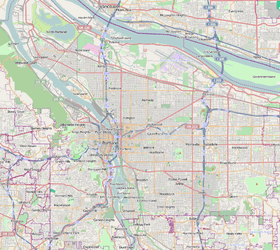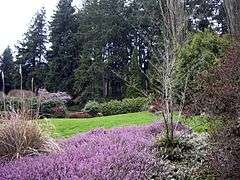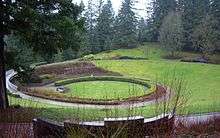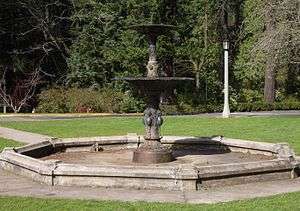Washington Park (Portland, Oregon)
| Washington Park | |
|---|---|
|
Garden near north entrance | |
 | |
| Nearest city | Portland, Oregon |
| Coordinates | 45°30′57″N 122°42′27″W / 45.51583°N 122.70750°WCoordinates: 45°30′57″N 122°42′27″W / 45.51583°N 122.70750°W |
| Area | 410 acres (170 ha) |
| Created | 1909 |
| Operated by | Portland Parks & Recreation |
Washington Park is a public urban park in Portland in the U.S. state of Oregon. It includes a zoo, forestry museum, arboretum, children's museum, rose garden, Japanese garden, amphitheatre, memorials, archery range, tennis courts, soccer field, picnic areas, playgrounds, public art and many acres of wild forest with miles of trails. Washington Park covers more than 410 acres (166 hectares) on mostly steep, wooded hillsides which range in elevation from 200 feet (61 m) at 24th & W Burnside to 870 feet (265 m) at SW Fairview Blvd. It comprises 159.7 acres (64.63 hectares) of city park land that has been officially designated as "Washington Park" by the City of Portland,[1] as well as the adjacent 64-acre (26 ha) Oregon Zoo and the 189-acre (76 ha) Hoyt Arboretum, which together make up the area described as "Washington Park" on signs and maps.[2]
History
The City of Portland purchased the original 40.78 acres (16.5 hectares) in 1871 from Amos King for $32,624, a controversially high price for the time.[3][4] The area, designated "City Park", was wilderness with few roads. Thick brush, trees and roaming cougar discouraged access. In the mid-1880s, Charles M. Meyers was hired as park keeper. A former seaman without landscape training, he transformed the park by drawing on memories of his native Germany and European parks. By 1900, there were roads, trails, landscaped areas with lawns, manicured hedges, flower gardens, and a zoo. Cable cars were added in 1890 and operated until the 1930s. The City of Portland constructed two reservoirs in the park in 1893 and 1894.[5]
In 1903, John Charles Olmsted of Olmsted Brothers, a nationally known landscape architecture firm, recommended several changes to the park including the present name, location of the entrance, separate roads and pedestrian paths, and replacement of formal gardens with native species. The name was officially changed from City Park to Washington Park in 1909.[6]
When the Multnomah County Poor Farm Hillside Farm west of Washington Park closed in 1922, the 160 acres (64.75 hectares) were donated to the City of Portland to be used as a park, which later became Hoyt Arboretum. [7]
Portland's zoo was founded in Washington Park in 1888 near where the reservoirs are presently located. It moved in 1925 to what is now the Japanese Garden, and moved again in 1959 to its present location at the park's southern edge. The only surviving structure from the old zoo is the elephant barn, now converted into a picnic shelter and decorated with tile mosaic of various animals and a life-size brick relief sculpture of an elephant and calf.
The City of Portland plans to demolish the two existing outdoor reservoirs, then replace them with underground reservoirs covered by reflecting pools, due to their age and a federal mandate to cover all reservoirs.[8] The $67 million project has attracted opposition from historical preservationists and residents concerned about construction impacts.[9]
Notable features
- Washington Park has over 15 miles (24 km) of trails, some of which are part of the 40-Mile Loop connecting Washington Park with Pittock Mansion and Forest Park to the north and Council Crest to the south.
- The Oregon Zoo contains more than 2,000 animals of more than 250 species (including 21 endangered species) in natural or semi-natural habitats.[10] The zoo has a notable Asian elephant breeding program and is home to Packy, the largest example of the species in the USA.
- The Washington Park Amphitheater hosts many public concerts, including the Washington Park Summer Festival, an annual free concert series normally presented in the first two weeks of August.[11]
- The Portland Japanese Garden is a 5.5-acre (2.2 ha) private traditional Japanese garden. It is the most highly ranked Japanese garden in North America of more than 300 such gardens rated by experts from The Journal of Japanese Gardening in 2013.[12]
- The International Rose Test Garden is the oldest official, continuously-operated, public rose test garden in the United States. Dedicated in 1924, it displays more than 7,000 rose plants of more than 500 varieties. It includes a Shakespeare garden within its boundaries, as well as an alpine garden at its southern end.
- The Rose Garden Children's Park is a playground that was completed in 1995 with $2 million in donations. It includes a large, colorful play structure designed to accommodate all children, including those with disabilities. Adjacent to the Children's Park is the Elephant House picnic shelter, converted from the old zoo's elephant barn.
- The World Forestry Center Discovery Museum offers educational exhibits on forests and forest-related subjects. It was founded in 1906 in the Forestry Building of the Lewis and Clark Centennial Exposition in Northwest Portland, and later established in Washington Park in 1971. Permanent exhibits explore the traits of forests around the world. Temporary exhibits have featured art (usually related to nature), ecology, wildlife and woodcrafts.
- The Oregon Holocaust Memorial was dedicated on August 29, 2004, to the victims of the Holocaust.[13]

- The Washington Park station is located beneath Les AuCoin Plaza, a scenic xeriscaped brick and stone terraced plaza located between the zoo and the World Forestry Center. The Washington Park Station is the only underground stop on the MAX Light Rail system and at 260 feet (79 m) below ground is the deepest transit station in North America.[14] The station is accessed by four high-speed elevators.
- Hoyt Arboretum contains nearly 10,000 individual trees and shrubs of 1,100 species on 187 acres (75.68 hectares) and was founded in 1928.
- The Oregon Vietnam Veterans Memorial was dedicated in 1987 to honor Oregonians who were killed or missing in action.
- The Portland Children's Museum, founded in 1946, moved into the Oregon Museum of Science and Industry's former building in 2001.
- The Washington Park & Zoo Railway is a 1950s-era, 2 ft 6 in (762 mm) narrow gauge railroad designed to carry passengers on a 2-mile (3.2 km) line between the Rose Garden and the zoo. Currently, it is partially closed because of needed maintenance on retaining walls and culverts as it runs through the woods; until that work is done, it operates only within the zoo.[15]
The veterans memorial, zoo, children's museum, forestry center and the MAX station surround a large parking lot in the southwestern portion of the park. The arboretum is located just to the north of these. The gardens, amphitheater, playgrounds and the Holocaust Memorial are in the northeast section of the park.
Image gallery
 *Washington Park sign
*Washington Park sign *Park main entrance
*Park main entrance *View of Mount Hood
*View of Mount Hood *Park garden at night
*Park garden at night
Statues and fountains
- The Lewis and Clark Memorial Column was dedicated by President Theodore Roosevelt on May 21, 1903, to honor the discovery of the northwest by the Lewis and Clark Expedition.[13]
- Coming of the White Man is a bronze statue of two Native Americans, one depicting Chief Multnomah. Sculpted by Hermon Atkins MacNeil in 1904 and donated by the heirs of David P. Thompson.[13] It faces east along the Oregon Trail.
- Sacajawea and Jean-Baptiste is a statue of the famed Shoshone native American woman who guided the Lewis and Clark Expedition through the mountains. A massive bronze and copper piece unveiled on July 7, 1905, at the Lewis and Clark centennial, it was sculpted by Denver resident Alice Cooper and cast in New York.[13][16]
- Chiming Fountain, also referred to as Washington Park Fountain, is so-called because of the sound the falling water makes. It is an ornate concrete, bronze and iron fountain with gargoyles. It was created in 1891 by the Swiss artisan woodcarver Hans Staehli in the style of a Renaissance fountain.[13]
- Loyal B. Stearns Memorial Fountain, erected in 1941 in honor of the former Oregon judge Loyal B. Stearns, is located in the northeastern corner of Washington Park, just south of Burnside Street.[17]
- Frank E. Beach Memorial Fountain (officially titled Water Sculpture), a stainless steel fountain located in the Rose Garden, was designed and built by Oregon artist Lee Kelly and dedicated in 1975.[18]
- Royal Rosarian is a bronze statue located in the Rose Garden that depicts a Royal Rosarian tipping his hat. It was created by American artist Bill Bane and dedicated in 2011.[19]
In 2001, a memorial bench and plaque north of the Lewis and Clark Memorial were created to honor the Portland born journalist John Reed. The plaque has a quotation by Reed on his native city:
Portlanders understand and appreciate how differently beautiful is this part of the world—the white city against the deep evergreen of the hills, the snow mountains to the east, the everchanging river and its boat life—and the grays, blues and greens, the smoke dimmed sunsets and pearly hazes of August, so characteristic of the Pacific Northwest. You don’t have to point out these things to our people. Walters, I think, paints them with more affection and understanding than they have yet been painted.[20]
Public access
The Washington Park light rail station provides regional public transit access to the park's west end, including the Oregon Zoo. Seasonal public transit service within the park is provided by the Washington Park Shuttle, which connects with MAX light rail at the Washington Park station and operates from May through October, running seven days a week from June through Labor Day (early September) and otherwise on weekends.[21] Additionally, bus route 63-Washington Park, which runs seven days a week year-round, serves stops at the west and east ends of the park (including at the Rose Garden and Japanese Garden), but does not pass through most of the park.[22] The northeastern corner of the park, at NW 23rd Place and W. Burnside, is served by bus route 20-Burnside/Stark, which runs seven days a week.[23]
See also
References
- ↑ "Washington Park". Portland Parks & Recreation. Retrieved January 23, 2011.
- ↑ "Washington Park, Portland, Oregon website". Washington Park Alliance. Retrieved January 23, 2011.
- ↑ MacColl, E. Kimbark (November 1976). The Shaping of a City: Business and politics in Portland, Oregon 1885 to 1915. Portland, Oregon: The Georgian Press Company. OCLC 2645815.
- ↑ "Washington Park". Portland Parks & Recreation. Retrieved November 22, 2006.
- ↑ "Washington Park Reservoir Improvements Project". Portland Water Bureau. Retrieved January 26, 2016.
- ↑ "Summary of park's board minutes 1901–1920". Portland Parks and Recreation. Retrieved November 22, 2006.
- ↑ "History of the Arboretum Part I". Portland Parks and Recreation. Retrieved September 9, 2016.
- ↑ "Washington Park Reservoir Improvements Project". Portland Water Bureau. Retrieved 10 June 2015.
- ↑ "Protests echo as council approves reservoir demolition". Portland Tribune. 13 May 2015. Retrieved 10 June 2015.
- ↑ "About the Oregon Zoo". Retrieved April 11, 2012.
- ↑ "Washington Park Summer Festival opens with record attendance". Portland Parks & Recreation. August 4, 2009. Retrieved January 23, 2011.
- ↑ "North America's Best Japanese Gardens" (PDF). Sukiya Living Magazine (JOJG). Retrieved January 17, 2016.
- 1 2 3 4 5 "Washington Park". Portland Parks & Recreation. Retrieved June 15, 2012.
- ↑ "Westside MAX Tour Fact Sheet" (PDF). TriMet. November 2009. Retrieved May 3, 2011.
- ↑ "Washington Park and Zoo Railway". Oregon Zoo. Retrieved September 9, 2016.
- ↑ "Sculpture of Sacagawea and Jean Baptiste". Lclark.edu. September 5, 2004. Retrieved June 15, 2012.
- ↑ "Art Inventories Catalog". Smithsonian American Art Museum. Retrieved January 22, 2011.
- ↑ "International Rose Test Garden – Washington Park". Portland Parks & Recreation. Retrieved January 23, 2011.
- ↑ Hottle, Molly (October 9, 2011). "Royal Rosarians unveil bronze statue to mark upcoming centennial year". The Oregonian. Advance Publications. Retrieved January 25, 2016.
- ↑ http://www.lclark.edu/~polyecon/reed.htm FIRST MEMORIAL TO JOHN REED TO BE DEDICATED MAY 6 by Michael Munk, The Portland Alliance, May 2001
- ↑ "Explore Washington Park". Washington Park Transportation Management Association. Retrieved September 9, 2016.
- ↑ Bus Line 63-Washington Park TriMet. Retrieved September 9, 2016.
- ↑ Bus Line 20-Burnside/Stark TriMet. Retrieved January 23, 2011.
External links
| Wikimedia Commons has media related to Washington Park. |





